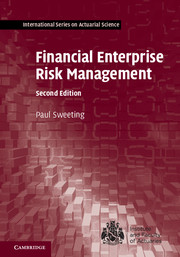Book contents
- Frontmatter
- Contents
- Preface
- 1 An Introduction to Enterprise Risk Management
- 2 Types of Financial Institution
- 3 Stakeholders
- 4 The Internal Environment
- 5 The External Environment
- 6 Process Overview
- 7 Definitions of Risk
- 8 Risk Identification
- 9 Some Useful Statistics
- 10 Statistical Distributions
- 11 Modelling Techniques
- 12 Extreme Value Theory
- 13 Modelling Time Series
- 14 Quantifying Particular Risks
- 15 Risk Assessment
- 16 Responses to Risk
- 17 Continuous Considerations
- 18 Economic Capital
- 19 Risk Frameworks
- 20 Case Studies
- 21 Solutions to Questions
- References
- Index
16 - Responses to Risk
Published online by Cambridge University Press: 12 August 2017
- Frontmatter
- Contents
- Preface
- 1 An Introduction to Enterprise Risk Management
- 2 Types of Financial Institution
- 3 Stakeholders
- 4 The Internal Environment
- 5 The External Environment
- 6 Process Overview
- 7 Definitions of Risk
- 8 Risk Identification
- 9 Some Useful Statistics
- 10 Statistical Distributions
- 11 Modelling Techniques
- 12 Extreme Value Theory
- 13 Modelling Time Series
- 14 Quantifying Particular Risks
- 15 Risk Assessment
- 16 Responses to Risk
- 17 Continuous Considerations
- 18 Economic Capital
- 19 Risk Frameworks
- 20 Case Studies
- 21 Solutions to Questions
- References
- Index
Summary
Introduction
Having not only identified and analysed risks but also compared the risks faced with the stated risk appetite, the next stage is to respond to those risks. The responses to risk are generally placed into one of four categories:
• reduce;
• remove;
• transfer; or
• accept.
There is little point in trying to fit every potential risk response into one of these categories, since there is often ambiguity about where a particular treatment belongs. The main purpose of detailing these four groups is to ensure that all potential responses are considered in relation to a risk as it arises.
Risk Reduction
Risk reduction involves taking active steps to limit the impact of a risk occurring. This group of risks includes approaches such as diversification. Diversification involves combining a risk with other uncorrelated risks, or at least with one or more risks whose correlation with the original risk is less than one. At the extreme, it can involve taking on risks which have a high negative correlation with the original risk faced, in which case it becomes hedging rather than just risk reduction. Whilst this approach is most obviously connected to investments, it can also relate to the choice of projects on which a firm embarks. Risk reduction can also involve the creation of more robust systems and processes, in order to reduce the chance of a risk emerging, or to limit the impact of a risk if it does emerge.
Risk Removal
Removing a risk means ensuring that an institution is no longer exposed to that risk at all. To achieve this, a firm can choose to avoid a project or an investment altogether, or can decide to achieve its aims differently. For example, a firm concerned about counter-party risk from over-the-counter OTC swaps could instead use exchange traded derivatives.
Risk Transfer
Risk transfer is a key response to risk. It involves, as the name suggests, transferring the consequences of a risk event to another party. Two important categories are non-capital market and capital market risk transfer.
- Type
- Chapter
- Information
- Financial Enterprise Risk Management , pp. 429 - 475Publisher: Cambridge University PressPrint publication year: 2017

